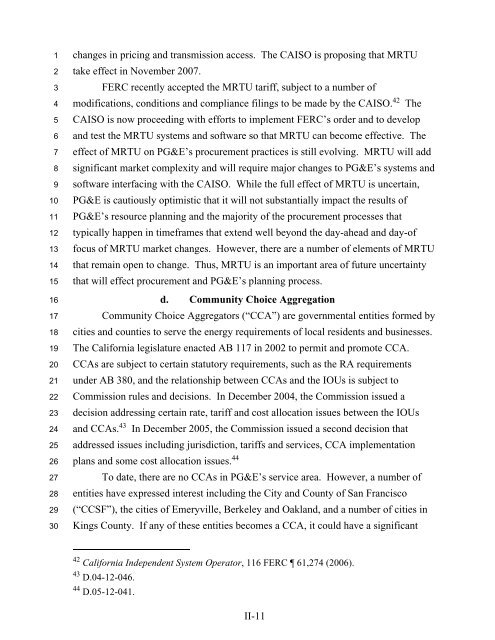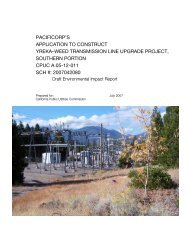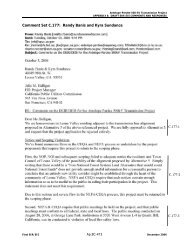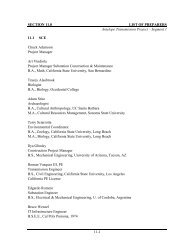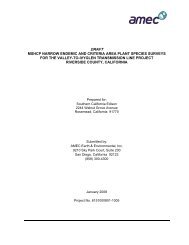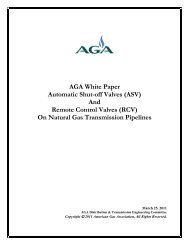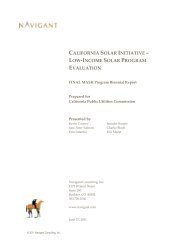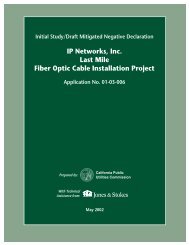Volume I. Part I - California Public Utilities Commission
Volume I. Part I - California Public Utilities Commission
Volume I. Part I - California Public Utilities Commission
Create successful ePaper yourself
Turn your PDF publications into a flip-book with our unique Google optimized e-Paper software.
1<br />
2<br />
3<br />
4<br />
5<br />
6<br />
7<br />
8<br />
9<br />
10<br />
11<br />
12<br />
13<br />
14<br />
15<br />
16<br />
17<br />
18<br />
19<br />
20<br />
21<br />
22<br />
23<br />
24<br />
25<br />
26<br />
27<br />
28<br />
29<br />
30<br />
changes in pricing and transmission access. The CAISO is proposing that MRTU<br />
take effect in November 2007.<br />
FERC recently accepted the MRTU tariff, subject to a number of<br />
modifications, conditions and compliance filings to be made by the CAISO. 42 The<br />
CAISO is now proceeding with efforts to implement FERC’s order and to develop<br />
and test the MRTU systems and software so that MRTU can become effective. The<br />
effect of MRTU on PG&E’s procurement practices is still evolving. MRTU will add<br />
significant market complexity and will require major changes to PG&E’s systems and<br />
software interfacing with the CAISO. While the full effect of MRTU is uncertain,<br />
PG&E is cautiously optimistic that it will not substantially impact the results of<br />
PG&E’s resource planning and the majority of the procurement processes that<br />
typically happen in timeframes that extend well beyond the day-ahead and day-of<br />
focus of MRTU market changes. However, there are a number of elements of MRTU<br />
that remain open to change. Thus, MRTU is an important area of future uncertainty<br />
that will effect procurement and PG&E’s planning process.<br />
d. Community Choice Aggregation<br />
Community Choice Aggregators (“CCA”) are governmental entities formed by<br />
cities and counties to serve the energy requirements of local residents and businesses.<br />
The <strong>California</strong> legislature enacted AB 117 in 2002 to permit and promote CCA.<br />
CCAs are subject to certain statutory requirements, such as the RA requirements<br />
under AB 380, and the relationship between CCAs and the IOUs is subject to<br />
<strong>Commission</strong> rules and decisions. In December 2004, the <strong>Commission</strong> issued a<br />
decision addressing certain rate, tariff and cost allocation issues between the IOUs<br />
and CCAs. 43 In December 2005, the <strong>Commission</strong> issued a second decision that<br />
addressed issues including jurisdiction, tariffs and services, CCA implementation<br />
plans and some cost allocation issues. 44<br />
To date, there are no CCAs in PG&E’s service area. However, a number of<br />
entities have expressed interest including the City and County of San Francisco<br />
(“CCSF”), the cities of Emeryville, Berkeley and Oakland, and a number of cities in<br />
Kings County. If any of these entities becomes a CCA, it could have a significant<br />
42 <strong>California</strong> Independent System Operator, 116 FERC 61,274 (2006).<br />
43 D.04-12-046.<br />
44 D.05-12-041.<br />
II-11


